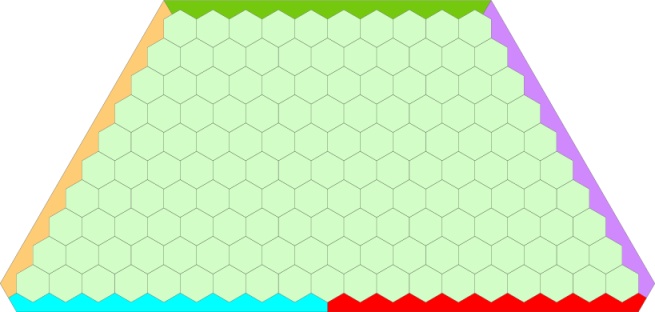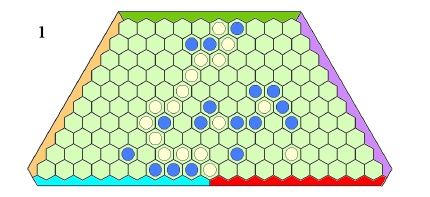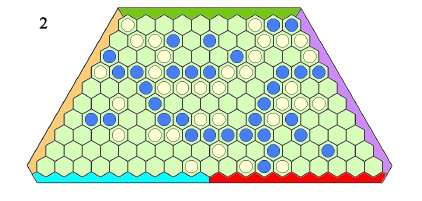
Trap Y is an abstract two player game which is played on a grid of hexagons in the overall shape of a trapezoid. Credit is due to Ea Ea, inventor of *Star, Y, (along with Charles Titus) and Star Y, for the concept behind this game. The perimeter of the trapezoidal grid is partitioned into five different color regions. Each region is adjacent to ten hexagonal cells along an edge.
The board is empty at the start. One player has a collection of yellow tokens, and the other player has blue tokens. Blue moves first. Each move consists of placing one token of your color on any vacant cell. Players alternate moves. Tokens do not move. There is no capturing.
After blue places the first token on the board, the opponent has the option to swap that token to yellow, if desired, instead of moving normally. A yellow token replaces the blue token, which is returned to blue's supply. This option is available only to yellow, and only immediately after blue's first move, not at any other point in the game.
Any two adjacent tokens on the board are said to be connected to each other. Any token X, which is adjacent to a group of tokens the same color as X, is part of that connected group.
The object is to form a connected group of tokens of your color which is adjacent to three of the five perimeter regions, with the proviso that one of the three regions must not be adjacent to either of the other two. If your group is adjacent to more than three regions, that also wins. You may resign, but you may not propose nor accept a draw.


This is the same as the game Star Y but on a different grid. Just as in Star Y, the game is always decisive. One player always wins, and the winning group always blocks the opponent from forming a winning group. In diagram 1, yellow has won, connecting the dark green, red, and turquoise regions. In diagram 2, blue has won by connecting red, purple, and orange-brown. Note that in diagram 2 yellow has connected orange-brown, dark green, and purple, but this is not a victory condition because each of those three regions is adjacent to at least one of the others.
Some of the cells on this board are much more important than other cells. In particular, the area, close to the center and both the red and turquoise regions, is often the main focus of the game. It would not be wise for blue to make the first move too close to this area, because yellow could swap that token and gain a winning advantage. Blue's best choice at the start of the game would be to find a move which gives both players approximately even chances.